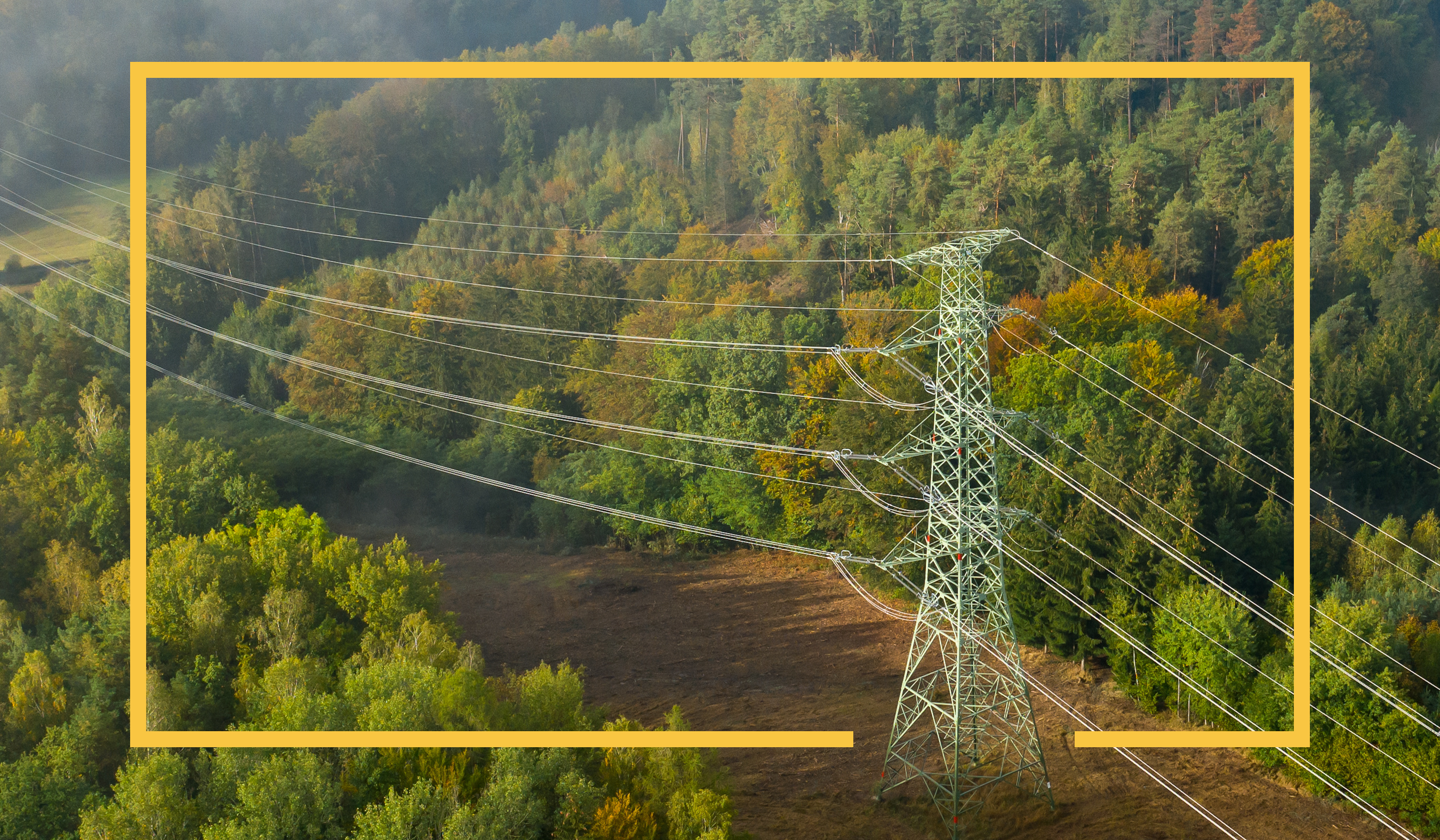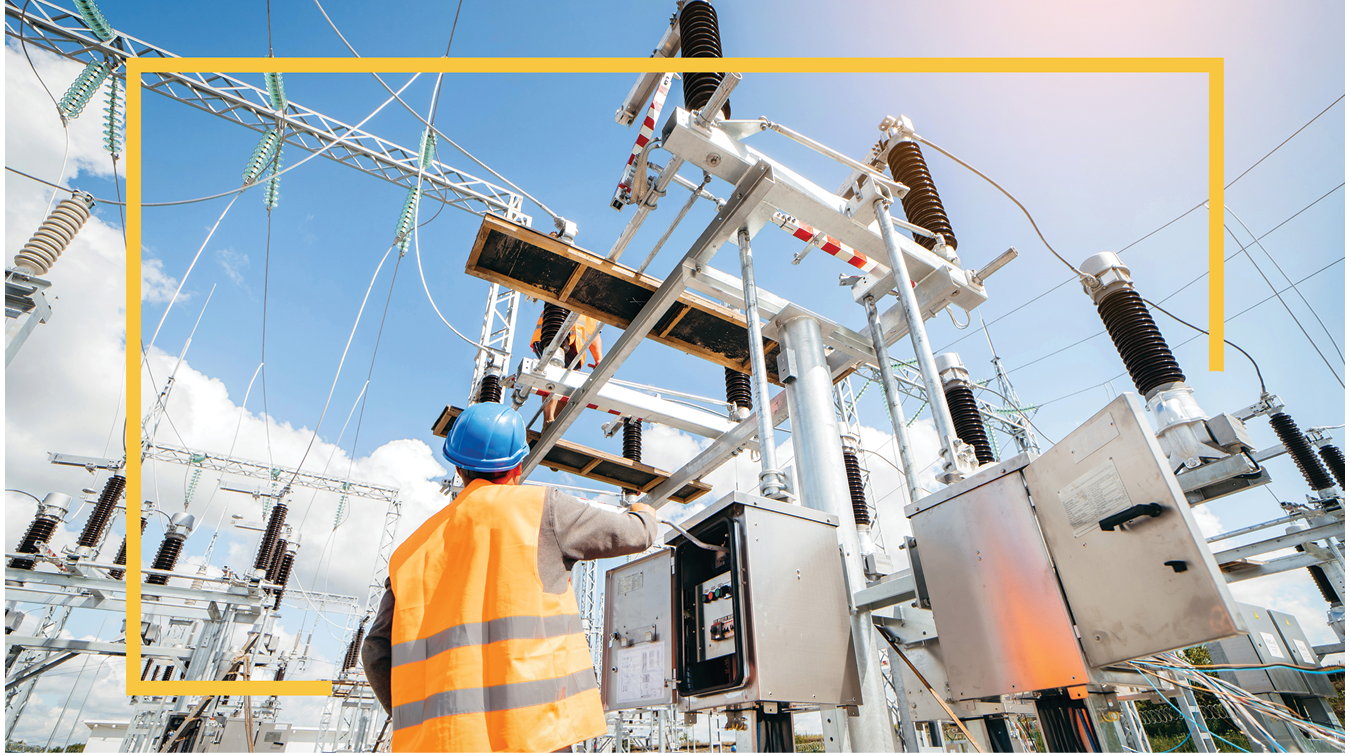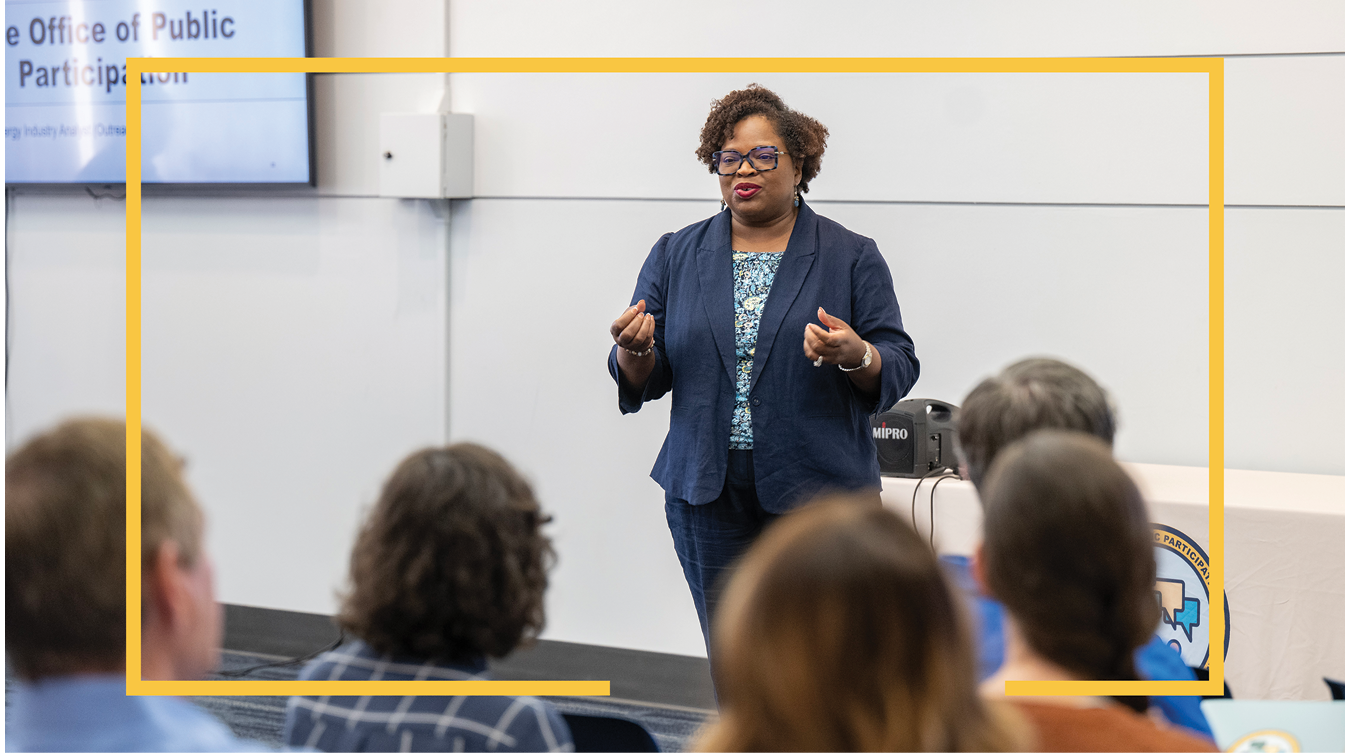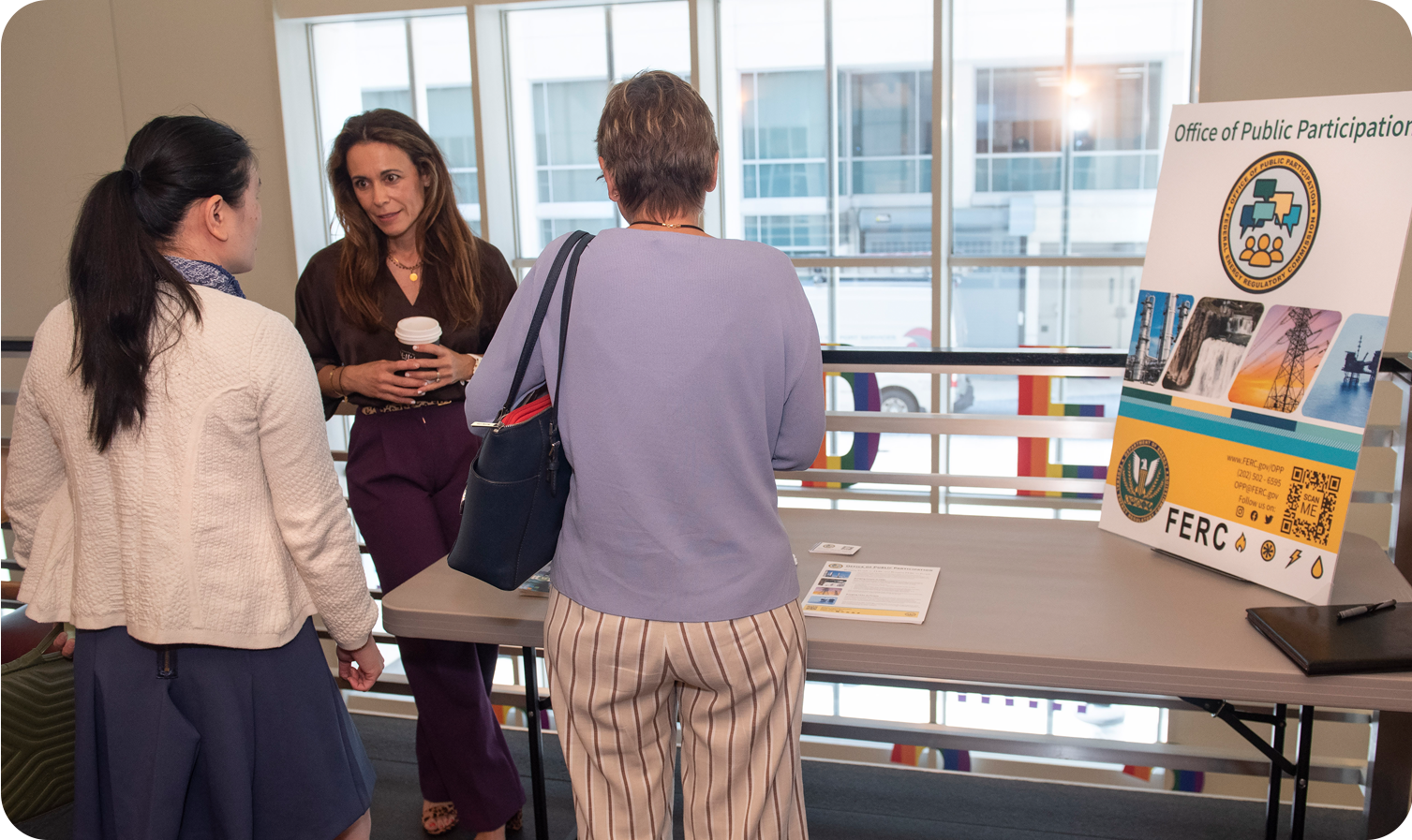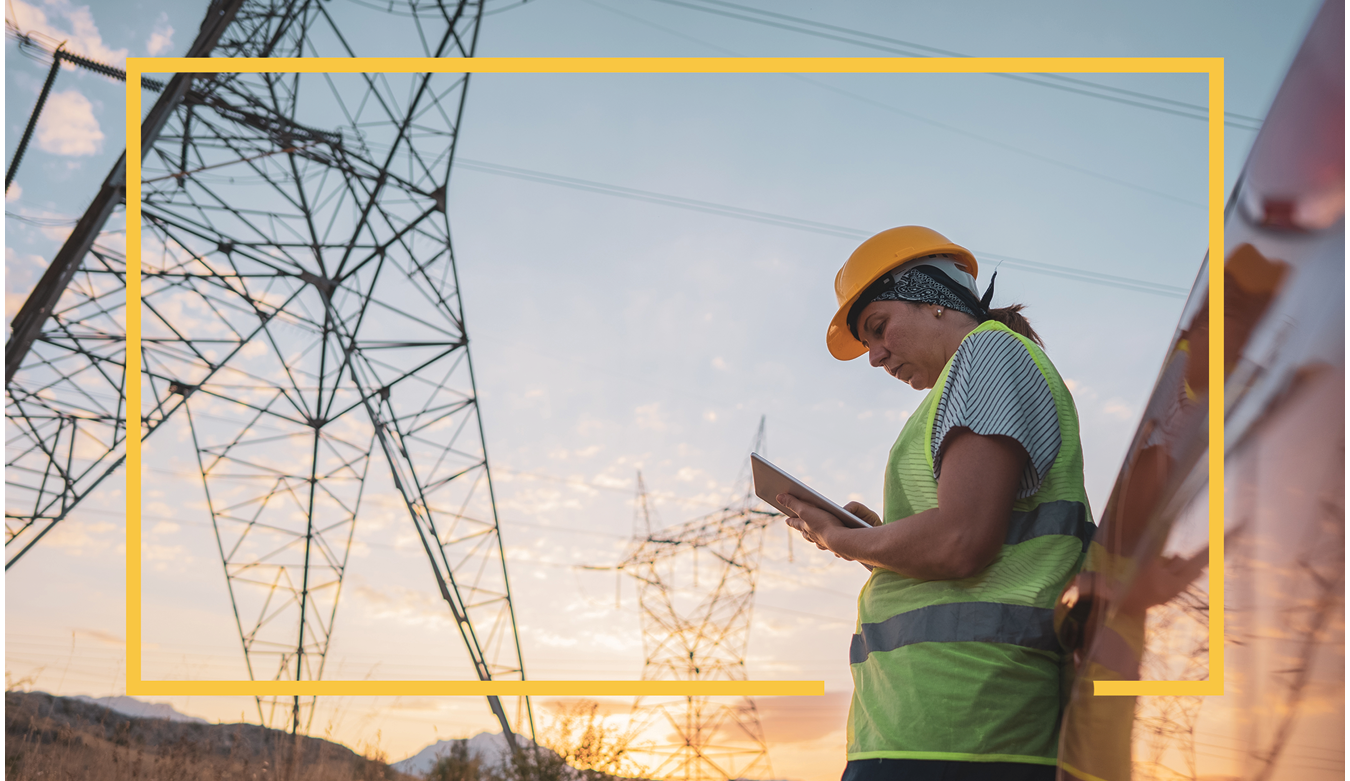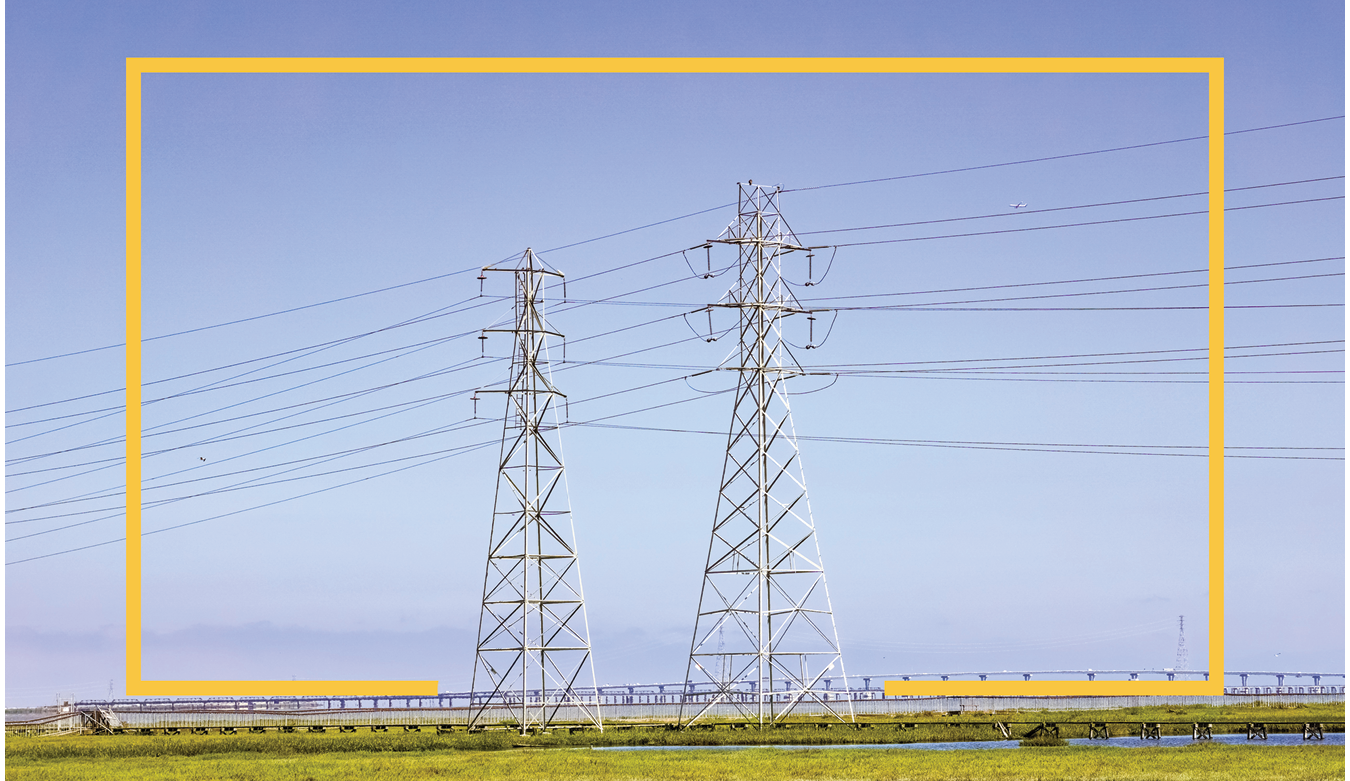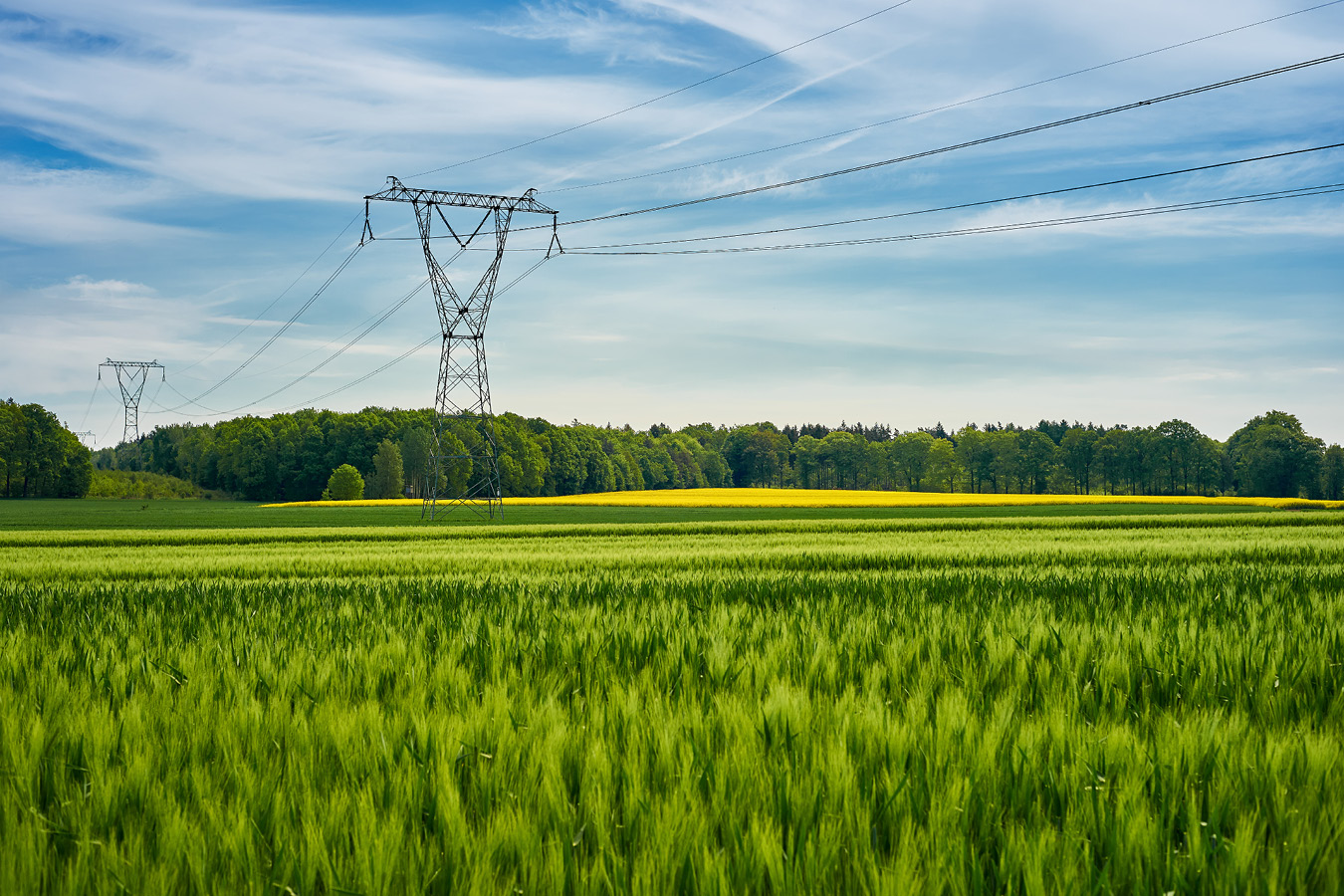Congress charged the Federal Energy Regulatory Commission (Commission or FERC) with evaluating whether to issue permits for the construction or modification of electric transmission facilities. Only certain electric transmission facilities that applicants propose to locate in National Interest Electric Transmission Corridors (National Corridors), as designated by the Department of Energy (DOE), are eligible for the FERC permit process. The Commission does not propose, construct, operate, or own such projects. You may be interested in the Commission’s permit proceedings if an electric transmission facility is proposed to be located on your land or near your home, business, or community.
This pamphlet generally explains the Commission’s permitting process for electric transmission facilities and focuses on some of the basic concerns of landowners and other stakeholders. The Commission’s process for evaluating electric transmission project applications is open and public, and designed to keep all stakeholders informed. We want you to know:
- The scope of the Commission’s transmission siting authority;
- How the Commission’s review processes work;
- How to learn about a project, access information, and participate in the review processes;
- How the location of electric transmission facilities is decided;
- What rights you have and the responsibilities of electric transmission developers;
- What safety and environmental issues might be involved; and
- How to contact Commission staff should additional information be needed.
The Commission’s Office of Public Participation (OPP) can be reached at 202-502-6595, or by email at [email protected], and will be happy to answer any further questions about the Commission’s procedures and provide guidance on participation.
Background
The authority to site electric transmission lines principally resides with the States. In the Energy Policy Act of 2005, Congress established a limited Federal role in electric transmission siting under the Federal Power Act. This Federal siting authority for electric transmission facilities is shared between the DOE and the Commission. The Federal Power Act, as amended in the Infrastructure Investment and Jobs Act of 2021, directs DOE to study electric transmission congestion and authorizes DOE to designate National Corridors. While the States continue to have jurisdiction over most electric transmission projects, the Federal Power Act grants FERC authority to issue permits to construct or modify electric transmission facilities that are within a National Corridor if:
- A State does not have the authority to approve the siting of facilities or to consider interstate or interregional benefits of the facilities;
- An electric transmitting utility does not qualify for siting approval in a State;
- A State has not made a determination on an application within one year;
- A State has conditioned its approval such that the project will not significantly reduce transmission capacity constraints or congestion, or is not economically feasible; or
- A State has denied an application.
Permitting Process
State Review Processes
If the proposed facilities are located in a State that has the authority to approve the siting of the facilities and to consider its interstate or interregional benefits, the applicant must file an application with that State. An applicant must be engaged in the relevant State siting processes for one year before seeking to initiate the FERC pre-filing process, which is described in more detail below. If the relevant States have already issued a decision, or lack the authority to approve the project, an applicant may ask the Commission to initiate pre-filing whenever sufficient project-related information is available.
Commission Review Processes
Before filing an application with the Commission, an applicant must participate in a pre-filing process, which is designed to encourage participation from all interested stakeholders early in the review of a proposed electric transmission facility and involves compiling the information necessary to file an application. Once the pre-filing process is complete, the applicant may file an application for FERC review.
As part of the application review process, Commission staff will conduct an environmental analysis to identify and inform stakeholders and the Commission of the potential environmental impacts of the proposed project and project alternatives, as required by the National Environmental Policy Act.
Initial Consultation
Before initiating the Commission’s pre-filing process, applicant representatives must meet with Commission staff to describe the proposed project. These meetings allow Commission staff to provide feedback on the environmental, engineering, and safety features of the proposed project. Based on this meeting, the applicant can further define its proposed project.
Pre-Filing Process
Once there is sufficient project information, the applicant may submit to the Commission’s Director of the Office of Energy Projects (Director) a request to initiate the pre-filing process. If the Director approves the request, the Commission will issue a notice initiating the pre-filing process. Within 14 days of the Commission’s notice, the applicant must notify stakeholders by mail, and publish in newspapers and online media, information about the project and the start of the pre-filing process.
The applicant is also required to develop a Project Participation Plan identifying specific tools and actions to facilitate stakeholder communication and the dissemination of public information about the proposed project.
The Project Participation Plan must also include an Public Engagement Plan and Tribal Engagement Plan. These two subplans must specify the targeted outreach methods that the applicant will use to engage these groups, summarize past outreach efforts and the comments the applicant received before entering the Commission’s pre-filing process, and describe how the applicant has engaged these groups about potential mitigation measures.
During the pre-filing process, Commission staff will review the applicant’s
proposal. Staff activities may include: conducting site visits, holding public meetings, facilitating the identification and resolution of environmental issues, and initiating the environmental review of the proposed project. The public will have multiple opportunities to review project information and provide comments for the Commission and applicant to consider. By engaging stakeholders early in the process, the applicant and Commission staff will become better informed of stakeholder concerns in a timely manner. With this early information, applicants can develop more robust application materials and the Commission can effectively address stakeholder concerns in its environmental documents. The work performed in the pre-filing process will form the basis for the application that is subsequently filed with the Commission.
Application Review Process
An application may be filed only after the Director has determined that all necessary information gathering during the pre-filing process is complete. Once the application is filed, Commission staff will conduct a comprehensive project review, including an environmental analysis. Commission staff will compile and carefully review all comments and recommendations from stakeholders and may conduct public meetings and technical conferences, as appropriate, to clarify project-related issues. Once the final environmental document is issued, the Commission will act on the permit application. The Commission must act within one year from the date that an application is filed with the Commission and the Commission has determined it has all the data it considers necessary.
Getting Involved
Q: How will I first hear about a proposed electric transmission facility?
You likely will first learn of a project through the State siting process. If you own property that may be affected by the project, you may first hear of it from the applicant as it collects the environmental information or conducts surveys to support State or federal permit applications. Other stakeholders may first hear of a project from discussions with friends and neighbors, at a public meeting held by the Commission or the applicant in your area, or through the outreach efforts of the Commission’s OPP.
Once the Commission’s mandatory pre-filing process is underway, you may learn about the proposed project through a variety of sources, such as open-house meetings, newspaper notifications, or notices mailed by FERC or the applicant.
Q: How can I obtain more details about a project or an application?
Commission records on a project are publicly accessible, and pre-filing or application materials may be viewed or downloaded free of charge from the Commission’s website at www.ferc.gov using the “eLibrary” link and the project’s docket number. User assistance is available by contacting [email protected] or calling 1-866-208-3676. Assistance is also available through the Commission’s OPP by calling 202-502-6595, or by email at [email protected].
The pre-filing and application materials also will be available in at least one physical location in each county in which the project is located. You also may obtain information from the applicant’s project-specific website.
Q: How do I make my views known?
One option is to contact the applicant directly with your questions, comments, or concerns. You may contact the applicant through the contact person listed in the notification you receive, or from the applicant’s project-specific website.
FERC provides you with the opportunity to comment at various stages of the review processes. If you want FERC to consider your views on the issues involving the location or environmental effects of the facility, you may submit your comments in writing or orally at any FERC-hosted meetings. Written comments may also be submitted either by conventional mail or by filing comments electronically at www.ferc.gov.
The Commission encourages electronic filing of comments. Written comments should be addressed to the Secretary of the Commission and must identify the project’s docket number, as this allows for the comment to be successfully entered into the record on the FERC eLibrary system. Details and instructions on how to file comments electronically or by mail are available on the Commission’s website at www.ferc.gov/how-file-comment, or by contacting the Commission’s OPP at 202-502-6595, or by email at [email protected].
Your filed comments will be considered and addressed in the Commission’s environmental documents or permitting decision. You also can use the Commission’s eRegistration and eSubscription systems (see www.ferc.gov) to keep track of individual proceedings at FERC. Users with an eRegistration account may subscribe to specific dockets and receive email notification when a document is added to eLibrary for the subscribed docket.
Q: What is an intervenor?
You may seek to become an intervenor in a proceeding once an applicant files its application. Instructions on how to do this are available from the Commission’s OPP and the FERC website at www.ferc.gov/how-intervene.
Becoming an intervenor gives you certain rights as well as some responsibilities. As an intervenor, you will be on the Commission’s service list and receive the applicant’s filings, other Commission documents related to the proceeding, and materials filed by other interested parties through your email. You will also be required to serve other parties with the filings that you make. Contact information for parties can be downloaded from the service list from the eService system (see www.ferc.gov). Service can be via email with a link to the document. If you are ultimately dissatisfied with FERC’s decision, as an intervenor you have the right to file for rehearing of the decision, and if you are still dissatisfied after that, you can appeal to a federal court.
Typically, you must file for intervenor status by the date identified in FERC’s notice of the application in the Federal Register, although the Commission may accept late intervention for good cause. You also may be able to file for intervenor status during the comment period for a draft environmental impact statement.
Please note that intervention requests are not applicable during the pre-filing process because there is no application officially filed before the Commission. You must wait until an application is filed with the Commission to intervene.
Q. Does the Commission have resources to help me better understand my participation options, procedural steps, and how to find more information about a project?
Yes, the Commission’s OPP supports meaningful public engagement and participation in Commission proceedings. OPP can help members of the public, including landowners, Tribal members and others, access publicly available information and navigate Commission processes. For public inquiries and assistance with making filings such as interventions, comments, or requests for rehearing, the public is encouraged to contact OPP at 202-502-6595 or [email protected].
OPP is prepared to help you to understand your options, determine the procedural status and next steps, and help you with your information needs. OPP has developed documents and some video demonstrations and workshops to help you:
- Use FERC’s eLibrary to find your proceeding and all filings;
- File a comment as well as tips for making your comments more powerful; and
- Learn how to intervene and learn the benefits and responsibilities of that level of participation.
OPP is not involved in decision-making in application proceedings and so you are free to speak with OPP about any concerns or needs you may have. OPP does not take sides, but rather has a support role to assist and provide information. You can contact OPP at any time during the review processes to gain information and tips on how to participate effectively. After you receive guidance from OPP, if you are ready to make a comment or other filing in the proceeding, you must submit your filing to the Commission so that it becomes part of the official record in FERC’s eLibrary system. OPP can help you make sure that the Commission has received your filing and entered it into the record.
You can access OPP’s videos at https://www.ferc.gov/OPP/workshopp-videos, and OPP’s other educational resources at https://www.ferc.gov/OPP.
Q: How may the Commission’s evaluation differ from that of a State?
Each State has its own evaluation criteria for electric transmission facilities. The factors the Commission must consider when deciding whether to issue a construction permit may be different from those considered in a State siting process.
When evaluating an application to site electric transmission facilities, Congress directed the Commission to consider specific criteria in the Federal Power Act. Specifically, the Commission may issue a permit to construct or modify electric transmission facilities that are located within a National Corridor if, among other things, the facilities:
- Will be used for the transmission of electricity in interstate commerce;
- Are in the public interest;
- Will significantly reduce transmission congestion and protect or benefit consumers;
- Are consistent with sound national energy policy and will enhance energy independence; and
- Will maximize the use of existing towers or structures, to the extent reasonably and economically possible.
The Commission may determine that a specific project meets these statutory criteria and issue a construction permit. This may be a different outcome than what resulted from the State siting process(es) based on different criteria.
Project Location and Easements
Q: How is the transmission line route selected?
The applicant identifies the project purpose and an initial proposed route or routes to achieve that purpose. During the pre-filing process, Commission staff work with the applicant and all other interested entities to better define the route. During this process, the applicant must study alternative routes or locations to reduce project-related impacts. Commission staff, the applicant, or other entities may suggest alternatives and modifications to reduce project impacts. As part of the environmental review, Commission staff analyze alternatives to the proposed project’s route, such as whether the transmission line can be placed near or within existing rights-of-way.
Q: How does the developer obtain a right-of-way?
The developer will try to negotiate a right-of-way easement, or the right to use land owned by another person for a limited purpose, and compensation for the easement with each landowner. Landowners may be paid for loss of certain uses of the land during and after construction, loss of any other resources, and any damage to property.
If the Commission authorizes the project and the developer cannot reach agreement with the landowner through negotiations, the developer may use eminent domain under section 216(e) of the Federal Power Act, which is a right that the law gives the applicant to acquire the right-of-way in court. For an applicant to use eminent domain, the Commission’s authorization must also include a determination that the applicant has made good faith efforts to engage with landowners and other stakeholders early in the permitting process (see Transmission Developer Responsibilities FAQs for more information on good faith efforts). If the developer acquires a right-of-way using eminent domain, compensation will be determined by a court.
Q: How large is the right-of-way and how is it maintained?
The width of the right-of-way depends on the type and voltage of the transmission line and what space is required for the safe construction and operation of the transmission line. Right-of-way widths of 100 to 200 feet would be typical for the types of projects we expect to seek Commission authorization. The transmission line operator must adhere to any applicable vegetation management standards required by the North American Electric Reliability Corporation.
Q: In general, are there any restrictions to using my land?
The easement document, whether negotiated or obtained via court-ordered eminent domain, will specify any restricted uses on or across the right-of-way and any types of uses for which the transmission line operator’s permission must be sought. Common restrictions for electric transmission rights-of-way include a prohibition on growing trees that may interfere with the electric lines or placing structures within the right-of-way.
Q: Must the developer obey local, county and State laws and zoning ordinances?
Generally, yes. However, if there is a conflict between these ordinances and what the Commission requires, the Commission requirement prevails.
Q: What if I have problems with erosion or other issues during restoration of the right-of-way?
The landowner should first contact the applicant to address and resolve the issue. If the landowner is not satisfied that the problem has been adequately addressed, they can contact the Commission’s Landowner Helpline at 1-877-337-2237 or send an email to [email protected].
Transmission Developer Responsibilities
Q: Must developer post bonds to guarantee performance?
No, but the Commission will inspect the right-of-way during and after construction to ensure that the terms of its permit are met.
Q: Why would the applicant approach me about an easement before the project is approved?
The applicant may try to obtain easement agreements in advance of project approval. An applicant may conduct environmental studies to support State or Federal permit applications. For these studies to be as complete as possible, the applicant may try to obtain access from the individual landowners along the entire length of the proposed right-of-way. You will want to review the terms of any agreements or contract carefully, and you have the right to hire legal counsel to review any contracts and represent you in dealings with the applicant. Further, disputes over the wording of an easement agreement are subject to State law.
Q: Can the developer come on my land without my permission?
State or local trespass laws apply, and procedures can vary by State. Some States have laws that allow a developer to gain access to property for survey purposes. Once it obtains an easement, survey agreement, or court order, the developer may enter your land subject to the agreement or court order.
Q: How does an applicant demonstrate to the Commission that it has made good faith efforts in its engagement, as required for the use of eminent domain?
The Commission has developed a voluntary Applicant Code of Conduct for applicants to demonstrate they have made good faith efforts to engage landowners throughout the pre-filing and application review processes. The Applicant Code of Conduct requires applicants to keep a record of discussions with affected landowners and provide landowners with certain project information, contact information, and a copy of the Commission’s Landowner Bill of Rights to ensure affected landowners are informed of their rights in their dealings with the applicant, in Commission proceedings, and in eminent domain proceedings that take place in court. The Applicant Code of Conduct also requires that applicants ensure that their communications with landowners are factually correct. Finally, the Applicant Code of Conduct includes general prohibitions against misconduct when applicants communicate with landowners, such as avoiding harassing, coercive, manipulative, or intimidating communications or high-pressure tactics. You may find the Applicant Code of Conduct in Appendix 1.
Applicants that choose not to comply with the Applicant Code of Conduct must file a statement with the Commission that they intend to rely on an alternative method of demonstrating that they meet the good faith efforts standard; provide a detailed explanation of the alternative method, including any commitments to recordkeeping, information-sharing, or other conduct; and explain how the alternative method is an equal or better way of ensuring that the good faith efforts standard is met.
Q: When can construction begin?
The developer cannot begin construction until Commission staff authorizes it to do so. Commission staff will authorize a developer to commence construction when the developer demonstrates compliance with the terms and conditions of the permit. Construction cannot commence until the Commission issues a permit, the developer accepts it, the developer receives all other necessary permits and authorizations, and the Commission issues authorization to begin construction.
Q: Can I receive service from the facilities?
No, the operation of interstate transmission facilities is incompatible with direct residential use, which is provided by local electric providers.
Environmental Issues
Q: What if my property contains endangered species, wetlands, or archaeological sites?
The Commission or the applicant must consult with the appropriate Federal, State, and local agencies, including but not limited to the U.S. Fish and Wildlife Service, U.S. Army Corps of Engineers, and State Historic Preservation Offices, regarding endangered species, wetlands, and archaeological sites, and follow all applicable laws and regulations to avoid or to minimize impacts to these resources. The results of agency consultations; disclosed impacts in the Commission’s environmental analysis under National Environmental Policy Act on endangered species, wetlands, archaeological sites and other environmental resources; and any proposed mitigation measures will be addressed in the Commission’s decision.
Q: What environmental reports will be prepared?
The applicant is required to prepare environmental reports addressing water resources, fish, wildlife, vegetation, cultural resources, Tribal resources, socioeconomics, geological resources, soils, land use, recreation, aesthetics, air quality, environmental noise, alternatives, reliability and safety, and design and engineering. The minimum filing requirements for these reports are described in section 380.16 of our regulations (18 C.F.R. § 380.16).
To obtain information needed for the environmental reports, the applicant may request access to your land to perform biological, cultural, or geotechnical surveys. The information collected from these surveys helps the applicant identify the presence of existing resources that may be affected by the proposed project and determine whether mitigation or alternative routes need to be considered.
Q: What environmental documents will be prepared by FERC?
Every project is different. FERC’s environmental review will build on any previous environmental review processes.
During the pre-filing process, the Commission will seek comments from stakeholders on the scope of its environmental review for a proposed project. After an application is filed, the Commission will issue a notice identifying whether staff will prepare an environmental assessment (EA) or an environmental impact statement (EIS), as required by the National Environmental Policy Act. After applicable comment periods, Commission staff will prepare and issue a Draft EIS or an EA outlining its findings and recommendations for public review. The Commission will consider and address any comments received on its Draft EIS or EA in the Final EIS or the final order granting or denying the permit.
Commission Contact Information
Office of Public Participation
Phone: (202) 502-6595
Email: [email protected]
Landowner Helpline
Toll Free: 1-877-337-2237
Email: [email protected]
FERC Online Support
Phone: (202) 502-6652
Toll Free: 1-866-208-3676
Email: [email protected]
Appendix 1 – Commission’s Applicant Code of Conduct
Title 18 of the Code of Federal Regulations Part 50.12 – Applicant code of conduct for landowner engagement.
Under section 216(e)(1) of the Federal Power Act, any applicant that may, upon receipt of a permit, seek to acquire the necessary right-of-way by the exercise of the right of eminent domain must demonstrate to the Commission that it has made good faith efforts to engage with landowners and other stakeholders early in the applicable permitting process. An applicant’s commitment to and compliance with the Applicant Code of Conduct during the permitting process is one way to demonstrate to the Commission that such good faith efforts have been made with respect to affected landowners.
- (a) Applicant code of conduct. To promote good faith engagement with affected landowners, applicants committing to comply with the Applicant Code of Conduct must for the duration of the pre-filing and application review processes:
- (1) Develop and maintain a log of discussions with affected landowners, organized by name and property address, that includes:
- (i) The name of the affected landowner;
- (ii) The substance of the items discussed;
- (iii) The nature of the contact (such as in-person, virtual meeting, telephone, electronic mail);
- (iv) The date of the contact; and
- (v) The status of discussions with the affected landowner following the contact, including any permissions granted, negotiations, or future meetings scheduled.
- (2) In addition to the Pre-filing Notification required by § 50.4(c)(1)(i) and (ii), provide to each affected landowner, prior to, during, or within 3 business days of after the first contact, a document that, at a minimum, includes: a description of the project, a description of the Commission and its role, a map of the project route, and the Landowner Bill of Rights in the form described in § 50.4(c)(2)(ii)(B). If the first contact with the affected landowner is in-person, the applicant must offer to provide the affected landowner at least one paper copy of the document. If the first contact with the affected landowner is by telephone, text, or electronic mail, the applicant may provide the affected landowner with a copy of the document by electronic means or by first class mail, at the affected landowner’s preference. The applicant must review the provisions of the document with the affected landowner upon request.
- (3) Ensure that any representative acting on the applicant’s behalf states their full name, title, and employer, as well as the name of the applicant that they represent, and presents a photo identification badge at the beginning of any discussion with an affected landowner, and provides the representative’s and applicant’s contact information, including mailing address, telephone number, and electronic mail address, prior to the end of the discussion.
- (4) Ensure that all communications with affected landowners are factually correct. The applicant must correct any statements made by it or any representative acting on its behalf that it becomes aware were:
- (i) Inaccurate when made; or
- (ii) Have been rendered inaccurate based on subsequent events, within three business days of discovery of any such inaccuracy.
- (5) Ensure that communications with affected landowners do not misrepresent the status of the discussions or negotiations between the parties. Provide an affected landowner upon request a copy of any discussion log entries that pertain to that affected landowner’s property.
- (6) Provide affected landowners with updated contact information whenever an applicant’s contact information changes.
- (7) Communicate respectfully with affected landowners and avoid harassing, coercive, manipulative, or intimidating communications or high-pressure tactics.
- (8) Except as otherwise provided by State, Tribal, or local law, abide by an affected landowner’s request to end the communication or for the applicant or its representative to leave the affected landowner’s property.
- (9) Except as otherwise provided by State, Tribal, or local law, obtain an affected landowner’s permission prior to entering the property, including for survey or environmental assessment, and leave the property without argument or delay if the affected landowner revokes permission.
- (10) Refrain from discussing an affected landowner’s communications or negotiations status with any other affected landowner.
- (11) Provide the affected landowner with a copy of any appraisal that has been prepared by, or on behalf of, the applicant for that affected landowner’s property, if any, before discussing the value of the property in question.
- (12) Ensure that any representative acting on the applicant’s behalf complies with all provisions of the Applicant Code of Conduct described in this paragraph (a).
- (1) Develop and maintain a log of discussions with affected landowners, organized by name and property address, that includes:
- (b) Compliance with Applicant Code of Conduct. Applicants committing to comply with the Applicant Code of Conduct must:
- (1) File, as part of the pre-filing request required by § 50.5(c), an affirmative statement that the applicant intends to comply with the Applicant Code of Conduct.
- (2) Include, as part of the monthly status reports required by § 50.5(e)(11):
- (i) An affirmation that the applicant and its representatives have, to the best of their knowledge, complied with the Applicant Code of Conduct during the month in question; or
- (ii) A detailed explanation of any instances of non-compliance with the Applicant Code of Conduct during the month in question and any remedial actions taken or planned.
- (3) Identify, in a filing with the Commission or as part of the monthly status reports required by § 50.5(e)(11), any known instances of non-compliance that were not disclosed in prior monthly status reports and explain any remedial actions taken in the current month to address instances of non-compliance occurring in prior months.
- (4) File monthly status reports providing the information required in paragraphs (b)(2) and (b)(3) of this section, for the duration of the application review process.
- (c) Compliance with an alternative method. Applicants not committing to comply with the Applicant Code of Conduct must:
- (1) File, as part of the pre-filing request required by § 50.5(c):
- (i) An affirmative statement that the applicant intends to rely on an alternative method of demonstrating that it meets the good faith efforts standard;
- (ii) A detailed explanation of the alternative method of demonstrating that it meets the good faith efforts standard, including any commitments to recordkeeping, information-sharing, or other conduct;
- (iii) An explanation of how the alternative method is equal to or better than compliance with the Applicant Code of Conduct as a means to ensure the good faith efforts standard is met;
- (iv) An explanation, for each component of the Applicant Code of Conduct with which it does not comply, why it did not follow that component; and
- (v) An explanation, for each component of the Applicant Code of Conduct with which it does not comply, why the alternative method is an equal or better means to ensure the good faith standard is met notwithstanding that deviation from the Applicant Code of Conduct.
- (1) File, as part of the pre-filing request required by § 50.5(c):

